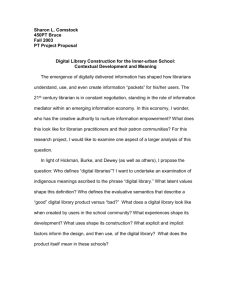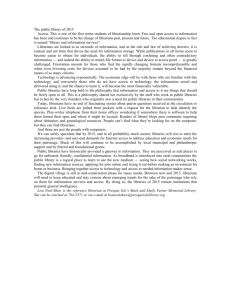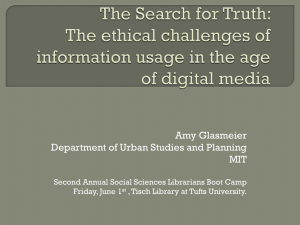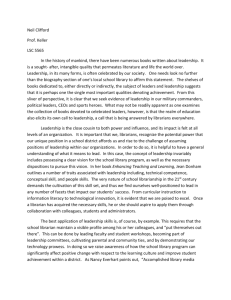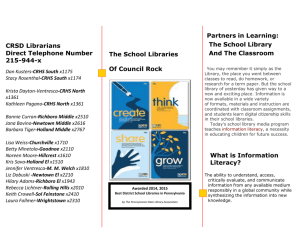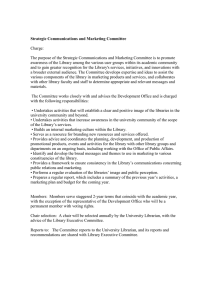Supplement to Teacher Librarian October 2002
advertisement
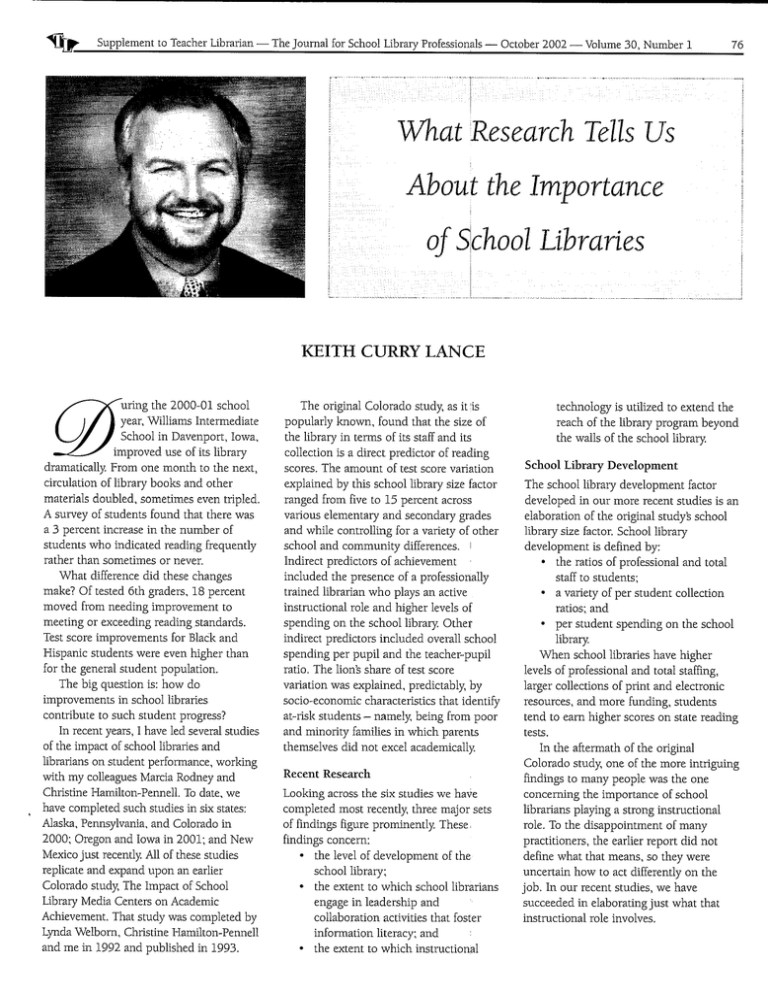
Supplement to Teacher Librarian ¶IQpr - The Joumal for School Library Professionals - October 2002 - Volume 30, Number 1 76 What Research Tells Us About the Importance of School Libraries KEITH CURRY LANCE uring the 2000-01 school year, Williams Intermediate J/// JSchool in Davenport, Iowa, improved use of its library dramatically, From one month to the next, circulation of library books and other materials doubled, sometimes even tripled. A survey of students found that there was a 3 percent increase in the number of students who indicated reading frequently rather than sometimes or never. What difference did these changes make? Of tested 6th graders, 18 percent moved from needing improvement to meeting or exceeding reading standards. Test score improvements for Black and Hispanic students were even higher than for the general student population. The big question is: how do improvements in school libraries contribute to such student progress? In recent years, I have led several studies of the impact of school libraries and librarians on student performance, working with my colleagues Marcia Rodney and Christine Hamilton-Pennell. To date, we have completed such studies in six states: Alaska, Pennsylvania, and Colorado in 2000; Oregon and Iowa in 2001; and New Mexico just recently. All of these studies replicate and expand upon an earlier Colorado study, The Impact of School Library Media Centers on Academic Achievement. That study was completed by Lynda Welborn, Christine Hamilton-Pennell and me in 1992 and published in 1993. ( l f j The original Colorado study, as it is popularly known, found that the size of the library in terms of its staff and its collection is a direct predictor of reading scores. The amount of test score variation explained by this school library size factor ranged from five to 15 percent across various elementary and secondary grades and while controlling for a variety of other school and community differences. Indirect predictors of achievement included the presence of a professionally trained librarian who plays an active instructional role and higher levels of spending on the school library. Other indirect predictors included overall school spending per pupil and the teacher-pupil ratio. The lion's share of test score variation was explained, predictably, by socio-economic characteristics that identify at-risk students - namely, being from poor and minority families in which parents themselves did not excel academically. Recent Research Looking across the six studies we have completed most recently, three major sets of findings figure prominently, These findings concern: * the level of development of the school library; * the extent to which school librarians engage in leadership and collaboration activities that foster information literacy; and * the extent to which instructional technology is utilized to extend the reach of the library program beyond the walls of the school library. School Library Development The school library development factor developed in our more recent studies is an elaboration of the original study's school library size factor. School library development is defined by: * the ratios of professional and total staff to students; * a variety of per student collection ratios; and * per student spending on the school library. When school libraries have higher levels of professional and total staffing, larger collections of print and electronic resources, and more funding, students tend to earn higher scores on state reading tests. In the aftermath of the original Colorado study, one of the more intriguing findings to many people was the one concerning the importance of school librarians playing a strong instructional role. To the disappointment of many practitioners, the earlier report did not define what that means, so they were uncertain how to act differently on the job. In our recent studies, we have succeeded in elaborating just what that instructional role involves. 77 Supplement to Teacher Librarian - The Journal for School Library Professionals - October 2002 - Volume 30, Number 1 Leadership In order to play an instructional role successfully, school librarians must exercise leadership to create the sort of working environment they need to help students and teachers succeed. Specific activities which define such leadership include: * meeting frequently with the principal, * attending and participating in faculty meetings, * serving on standards and curriculum committees; and * meeting with library colleagues at building, district, and higher levels. Allison Hutchison, librarian at Bald Eagle Area High School in Wingate, Pennsylvania, is a good example of the school librarian in a leadership role: "In my school," she reports, "the librarian is an integral part of the school steering committee which is made up of five area coordinators and other school leaders, such as the technology director We meet monthly and together we make decisions about many building-wide policies, most importantly, future curriculum directions. We review all curriculum proposals and decide which course changes and initiatives will be presented to the board. Not only do I get to provide input from my vantage point, which takes in the school's curriculum as a whole, but I also get to know in advance which content areas to emphasize in collection development." School librarians who serve as active leaders in their schools have a dramatic impact on teachers and students alike. Barbara St. Clair, librarian at Urbandale High School in Iowa, learned how quickly the impact of her leadership could be felt. "During the second week of school I visited every 9th grade classroom. I introduced students to the library and booktalked all 16 Iowa Teen Award books for this year. I keep them in a special place and as soon as one comes back it is checked out again, which makes me very happy, I gave each student a bookmark with the titles and each English teacher a poster about the books. Another English teacher at a different level said that he had heard that I gave really good book talks and asked me to pick out some books to present to his basic English class. Since then, I have had more requests for booktalks. A teacher also requested that I arrange a panel of teachers to talk about their favorite books with her class." Collaboration and Information Literacy When school librarians demonstrate this kind of leadership in their daily activities, they can create an environment conducive to collaboration between themselves and classroom teachers. That, in turn, enables them to work with classroom teachers to instill a love of reading and information literacy skills in their students. Collaboration activities in which school librarians should participate, according to our research, include. * identifying useful materials and information for teachers, * planning instruction cooperatively with teachers, * providing in-service training to teachers, and * teaching students both with classroom teachers and independently. It is these types of collaboration between librarians and teachers that are linked directly with higher reading scores. Consider the example of Eaglecrest High School in Aurora, Colorado, reported by social studies teacher Debbe Milliser: "Our school librarians - Barbara Thorngren, Pat Holloway, and Norma Nixon - work with our U.S. History and American Literature classes to do a research project from start to finish. Individual language arts and social studies teaching teams meet with the librarians before bringing students to the library. Students are taught the research process, including accessing and using both primary and secondary sources. My students' ability to access library books and other materials and to use information appropriately in their papers is very evident in the quality of their work. This project helps the juniors and seniors I teach to meet history, language arts, and library standards." Technology Perhaps the most dramatic changes since the original Colorado study have been in V the realm of instructional technology, More and more schools provide students and teachers with computer networks. At their best, school libraries are integrated into these networks in such a way that they enable school librarians to reach out more proactively to the school community. Such networks also enable students and teachers to use library media resources from wherever they are - in classrooms, labs, offices - even, in the best situations, from home. In our recent studies, we have found that in schools where computer networks provide remote access to library resources, particularly the Web and licensed databases, test scores tend to be higher. Becky Hickox, librarian at Silverton High School, reported to us on the impact of the Oregon School Library Information System. A 9th grade health project has evolved into a partnership between Hickox and teacher Erik Cross to introduce freshmen to the Internet. The cornerstone of this project is introducing the licensed databases made available through OSLIS. "Although students often come with some knowledge of the World Wide Web, none of them are familiar with subscription databases. I provide the basic instruction and help individuals construct searches," she says, "and Erik makes sure they are covering the required content." This project introduces students to the concept of finding pertinent information as lifelong learners and gives them a base of search strategies for future projects in almost any subject area. Controlling for School and Community Differences The most critical feature of the research design employed in our studies and in other recent studies based on the same design is controlling for other school and community differences. The earliest studies on school library impact failed to do this. As a result, those studies were subject to easy criticism. The event that precipitated the first Colorado study is an excellent example of this dilemma. In a 1987 National Public Radio interview, the head of School Match, a Westerville, Ohio, data vendor, reported that researchers at his firm had identified 914 Supplement to Teacher Librarian - The Journal for School Library Professionals school library spending - among a host of other variables - as the strongest predictor of scores on the National Averit Scholarship Test, But, when this claim was investigated, other researchers were not convinced. Perhaps it was not spending more on school libraries in particular, but spending more on everything - that is, simply being a rich school - that led to higher test scores. To preclude the dismissal of such findings about the importance of school libraries, our research design controls for a variety of school and community differences. The school differences included characteristics of teachers, such as their levels of education, experience, and compensation; - * the teacher-pupil ratio; and * total per pupil expenditures. The community differences included * poverty; * minority demographics; and * adult educational attainment. As a result, we have been able to demonstrate successfully in several diverse states that such differences do not explain away the importance of high-quality school libraries. Our research along these lines continues, currently in Michigan and California, and other states are in line to follow between now and 2004. Our methodology has been adapted by other researchers in studies of Massachusetts and Texas school libraries, yielding remarkably similar results to ours Still October 2002 - Volume 30, Number 1 other researchers are in the process of implementing our research design to study the impact of school libraries in other states. At this point, however, there is a clear consensus in the results now- available for eight states: School libraries are a powerful force in the lives of America's children. The school library is one of the few factors whose contribution to academic achievement has been documented empirically, and it is a contribution that cannot be explained away by other powerful influences on student performance. Keith Curry Lance, is Director,Library Research Service, ColoradoState Library 00 The Ne-Schuman Authoritative Guiide to Kids, Search Engines, Subject Directories, and Portals By Ken Hacock, Michele Dober, and BarbaraEdward Evaluations and recommendations for the top search engines, subject directories', and portals especially designed for kids. The authors explore the elements of a search tool, discuss ownership and do umentation, examine the selection and content colerage, look at display and navigation tools, search featu.res, results and rankings. Includes descriptions of online tutors and homework help sites The ideal reforence to keep close by the computer and to consult while online! B NNealSchuman 1-55570-451-4. 2003. 175 pp. $55. 78 COPYRIGHT INFORMATION TITLE: What Research Tells Us About the Importance of School Libraries SOURCE: Teacher Librarian 30 no1 O 2002 supp WN: 0227506345006 The magazine publisher is the copyright holder of this article and it is reproduced with permission. Further reproduction of this article in violation of the copyright is prohibited. To contact the publisher: http://www.teacherlibrarian.com/. Copyright 1982-2002 The H.W. Wilson Company. All rights reserved.
